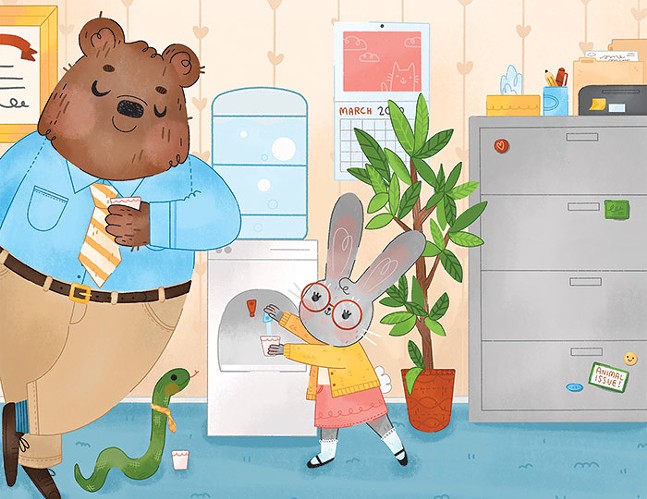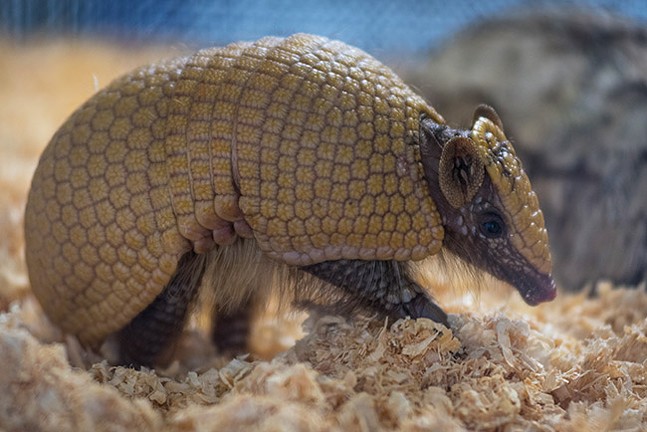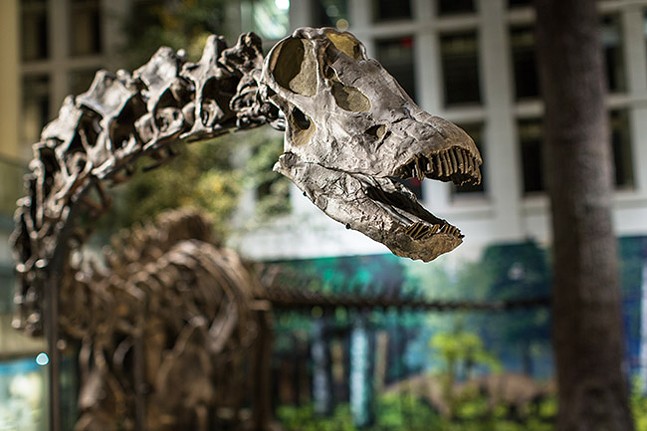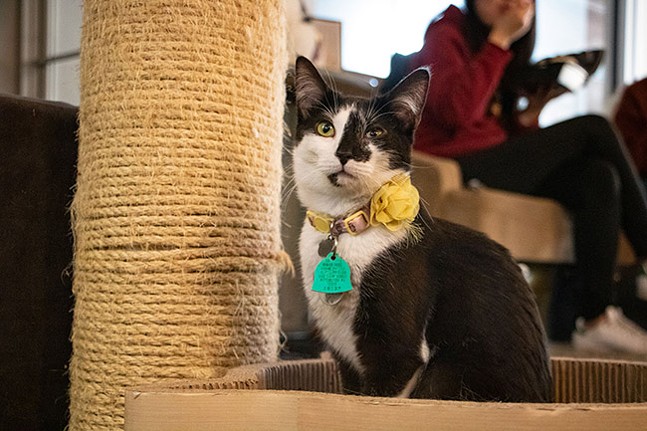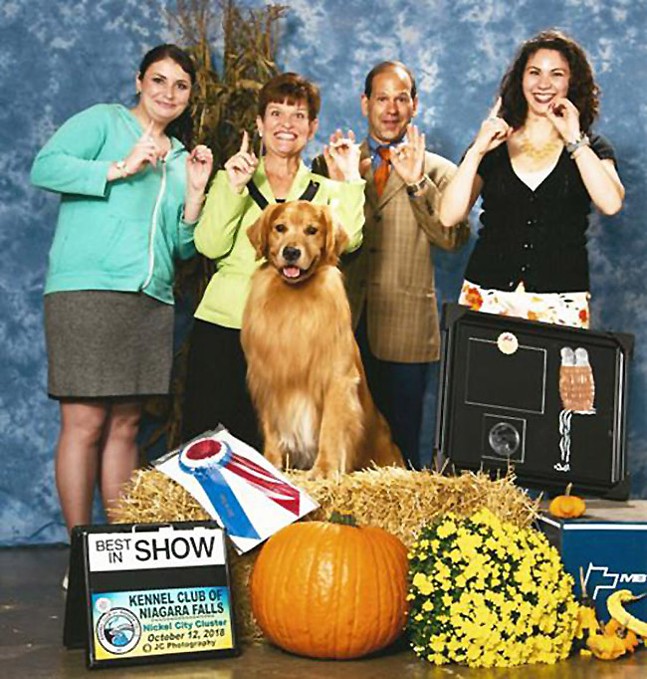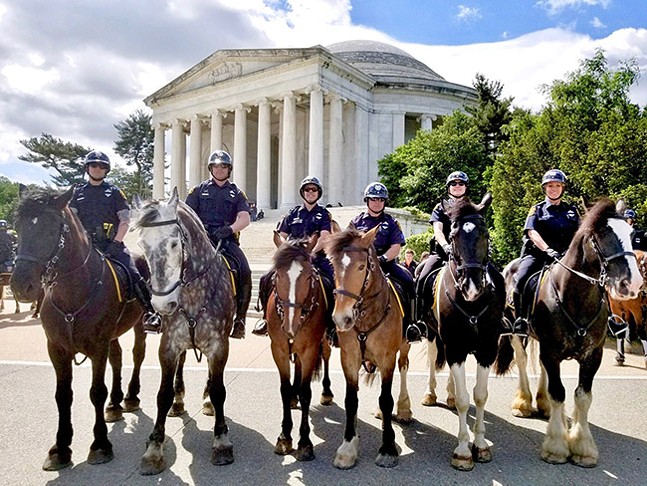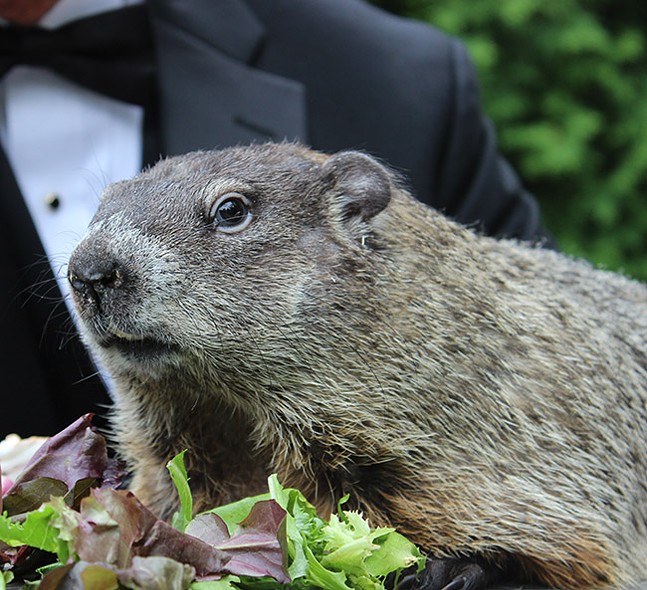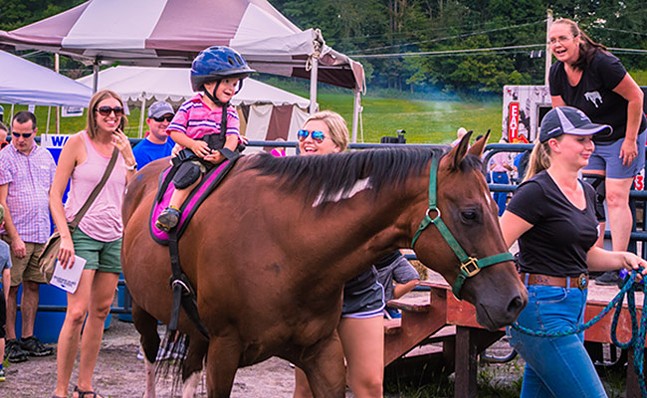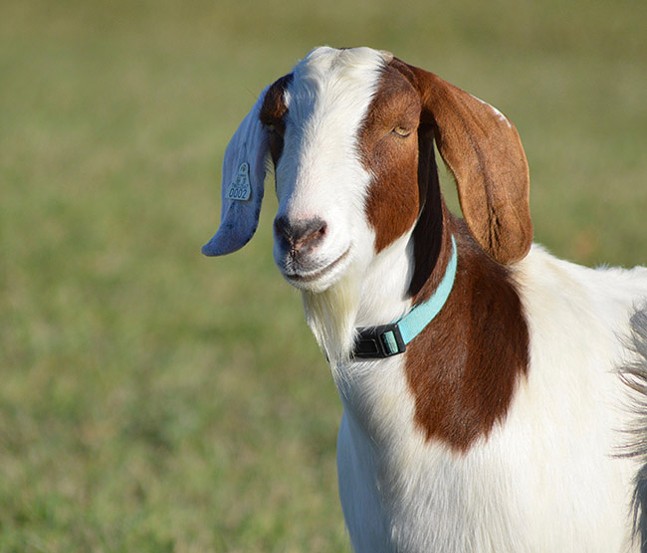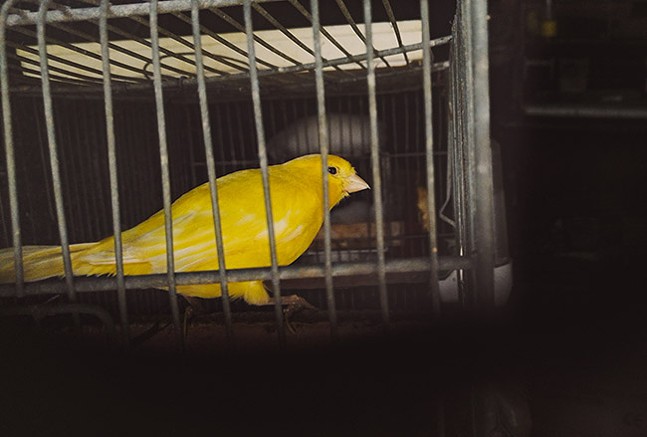For this year’s Animal Issue, we decided to focus on working animals who have jobs just like us. Since humans first domesticated animals, we’ve been using them for various kinds of labor, physical and otherwise. As human jobs and industries have evolved, so too have those for our furry, winged, and/or hoofed employees. Now, in addition to animals working in law enforcement or therapy, there are also animal influencers and landscapers.
In this issue, you’ll read about therapy dogs and horses that provide emotional and physical comfort, a highly decorated show dog, an armadillo that educates visitors at the National Aviary, goats that remove weeds and poison ivy, a Chihuahua influencer on Instagram, and more.
For each animal, you’ll find its job title, as well as its salary, because all living beings deserve to be paid for their work. Unfortunately, there is no universal animal currency (that we know of), so animals get paid in different forms: unlimited treats, a cushy home, and human affection. Unless, of course, you’re a show dog, in which case the salary is “the satisfaction of a job well done.”
Regardless of their job, salary, or breed, these animals have one thing in common that many humans can never obtain: They are extremely cute.
Name of animal: BrookeAnimal type: Golden Retriever
Job title: Animal Therapist
Salary: Lovies, meeting new people, making new friends.
At least five students are petting Brooke at once as she visits Point Park University during midterm exams. The Golden Retriever is a part of Campus Canines, a group of about 60 volunteer dogs (and their humans) who have been helping to alleviate the stress of college life at local campuses for the past 18 years.
The dogs also visit Duquesne University twice a month and the University of Pittsburgh every Tuesday. Marsha Robbins, founder of Campus Canines, says there is usually a line of people at Pitt every week, waiting their turn to start petting the dogs that come to each session.
“Scientific research shows the benefits to both the humans and the dogs,” says Robbins, who adds that the visits help lower blood pressure and alleviate anxiety, which explains why Point Park recruited the dogs during midterms.
Yes, “chemistry between people and dogs is real,” cites a 2015 study Oxytocin-gaze Positive Loop and the Coevolution of Human-dog Bonds. Oxytocin, deemed the “love hormone,” is released by both dogs and humans when they’re gazing into each other’s eyes.
Robbins says the dogs enjoy the visits just as much as the students, which could be, in part, because these animals know what it’s like going to school, too. To get the esteemed title of a “therapy dog,” every animal has to go through obedience classes and training at Humane Animal Rescue before getting their titles, and not all of the dogs who enter the program are up to the challenge.
But you don’t actually have to be a student to pet one of the dogs — the weekly sessions at Pitt are open to the public, so if you’re stressed out at work or home, you can come release some oxytocin, too.
Robbins says the dogs get paid in “lovies,” which is what their humans get paid too. All of the animals and their humans in the program, including Robbins, are volunteers. She said everyone continues to participate because they love dogs and love making people happy.
“We like doing our part to make the world a little better,” she says.
— Lisa Cunningham Name(s): Willy & Wonka
Job titles: Animal Ambassadors
Type/breed of animal: Southern Three-banded Armadillo
Salary/compensation: Willy and Wonka live in cushy armadillo penthouses and enjoy their favorite foods (worms and mushy fruit)!
In addition to peering in on penguins, owls, and other birds, visitors to the National Aviary can get up-close and personal with a variety of wingless creatures during Animal Encounters.
Willy and Wonka, two armadillos, meet with adults and children alike. The small mammal is distinct for its hard outer shell, which is more flexible than it looks.
“Visitors are always interested in learning about an armadillo’s primary method of defense: rolling up into a ball,” says Molly Toth, spokesperson for the Aviary. But visitors don’t usually get to see this mechanism, which Toth says is a good thing, because curling into a ball would mean they don’t feel safe and comfortable.
While visitors can’t hold the ‘dillos, they might get to lightly touch its armor. The little critters climb onto a bowl to show that they’re comfortable enough for a little touch. They can also sense people nearby with their “tiny, wiry hairs,” which gauge how close they are to objects around them.
Like other armadillos of their breed, Willy and Wonka are insectivores, meaning they consume a diet of ants, termites, and worms. “Much like the smell of coffee rouses people from slumber, Willy and Wonka enjoy a good worm to start their days,” says Toth.
When not engaging in encounters, Willy and Wonka like to hang out alone, explore, forage, and dig.
— Hannah Lynn
Job Title: Beloved Museum Mascot
Animal Type: Dinosaur (Diplodocus carnegii)
Name of Animal: Dippy
Salary: Paid in Twitter Followers and Scarves
Dippy the Dinosaur was born about 150 million years ago, but age is just a number for this world-famous dino hanging out at the Carnegie Museum of Natural History in Oakland.
According to museum marketing assistant Samantha Bastress, Dippy’s fossilized bones were discovered in Sheep Creek, Wyo., on July 4, 1899. He’s been on display at the Carnegie Museum since April 1907. Andrew Carnegie financed the acquisition of the skeleton in the late 1890s, and Dippy is formally named Diplodocus carnegii.
“He’s become ‘the dinosaur,’ or so to speak, which not a lot of people know about. He has four different replicas throughout Europe,” says Bastress. “He’s really popular with school kids over there.”
Even though he’s got replicas — or “brothers,” as Bastress called them — all around the world, the Dippy you’ll see at the museum in Oakland is almost entirely authentic; the few parts of him made of replica bones were made to fill in a few gaps in the skeleton.
The statue outside of the Carnegie Library in Oakland, just a few steps away from the museum, was made in Dippy’s likeness in 1999 to celebrate the 100th anniversary of his discovery. The statue is known for its fashionable outfits, including a top hat and bow-tie combo to celebrate the Royal Wedding in England, an 18-foot-long scarf knitted by a fan, and Harry Potter merchandise declaring his proud status as a Hufflepuff.
If you can’t make it out to the museum to see Dippy himself, fear not: He has a Twitter account, @Dippy_the_Dino, which has just surpassed 3,500 followers.
— Ollie Gratzinger
Name: Oja
Job title: Part-Time Pet (“all the love, none of the work”)
Type/breed of animal: Rescue Cat
Salary/compensation: Premium kennel-free accommodations, unlimited human-provided affection, and free healthcare (medical, dental, and vision)
The rescue cats at Colony Cafe sure do have it tough. Their job requirements entail looking cute, sleeping whenever they want, and meeting new people who are eager to play with them every day.
Since opening in 2017, the cat cafe (located at 1125 Penn Ave. in the Strip District) has adopted out over 300 cats through its rescue partner Animal Friends, averaging about two adoptions every week. Oja is a three-year-old feline who currently shares space with 11 other cats on the second floor loft where they have free range to roam 24/7 until they’re adopted.
But the cats provide a service to those who can’t adopt, too. They’re great part-time companions for anyone whose lease doesn’t allow pets or for those with allergic family members.
According to owner Sue Hendrickson, most of the cats are older rescues who often get overlooked at the shelter. Humans can reserve a one-hour visit for $8 per person, with discounts on Thursdays for college students with a valid school ID. And if you’re tired of the cubicle life, three-hour blocks are available for “co-working with cats” for $20.
“There is a noticeable difference in many guests’ stress levels from the beginning to the end of their Cat Loft visit,” says Hendrickson. “It means a lot that we can offer a brief respite after a rough day.”
That applies to the owner, too. Hendrickson says she wishes she could take all of the cats home every day. “I rationalize this by pretending they’re all mine, telling them, ‘Mama loves you’ after everyone leaves.”
— Lisa Cunningham
Job title: Show dog
Animal type: Golden Retriever (dog)
Name: Jack Daniels aka Daniel
Compensation: the satisfaction of a job well done
At six years old, Jack Daniels (“Daniel”) has accomplished more than some adult humans. He was named the best Golden Retriever nationwide in both 2018 and 2019, has won 19 Best in Shows, 26 victories at specialty shows (ones featuring only his breed), and most recently, won his group at the Westminster Dog Show in February. This is all in addition to being a new father (his daughter, Stevie Nix Gold Dust Girl, is now three).
With a trophy case as stacked as his, Daniel has settled comfortably into semi-retirement, says his owner/breeder Tammy Tomlinson of Hillock Golden Retrievers in Ligonier, adding that he’ll go out for the big shows and maybe go back to Westminster “if we like the judges.”
When the day finally comes to hang up his collar, Daniel will return to his first love (and breed specialty) of hunting, aka retrieving. In addition to his Hollywood looks and enviable smarts, Daniel is a consummate hunting buddy and overall just a terrific companion.
“His personality is ... anything you ask him to do, he will do for you,” says Tomlinson.
“Whatever it is, he’s game for anything.”
— Alex Gordon
Job Title: Police Patrol Horse
Animal Type: Shire breed
Name of Animal: Spirit
Salary: Apples, carrots, starlight mints
Spirit is one of the eight horses used by the City of Pittsburgh for patrolling and public relations. He was donated to the police by Pittsburgh Steelers defensive end Stephon Tuitt — all Pittsburgh Police horses are acquired through donation — after being found (alongside a cow) abandoned on an elderly couple’s farm by a vet tech in upstate New York. Both animals were rescued and listed for adoption on a website, and Tuitt purchased the horse for donation. (Maurkice Pouncey and Ramon Foster of the Steelers have also donated horses.)
Spirit is a Shire breed, which is a British breed of draft horse (working horse) and the largest in the world. They are often mistaken for Clydesdales because of the feathering around their hooves. The city’s police horses weigh between 1,400 and 2,000 pounds (one ton) and are 16 to 18 hands (hand = four inches) tall. Sampson, the largest horse ever recorded, was a Shire (3,360 pounds, 21.25 hands) from Bedfordshire, England.
Each horse goes through sensory training before they can be accepted by the police, as everyday details in cities, such as painted white lines, can startle a horse. One of the tests is to see how they react when an inflatable ball is thrown past them, which determines whether they are easily rattled.
If you see a police horse on the street, feel free to go up and ask the officer questions. Pittsburgh Police Commander Ed Trapp says that the officers love to talk about the horses. It wouldn’t hurt if you carried around some starlight mints, as the horses love them and will be able to find them if you have them in your pocket. Watch out for Lord Stanley, though. He has a bit of a slobbering issue, according to Trapp.
— Josh Oswald
Job Title: Seer of Seers, Sage of Sages, Prognosticator of Prognosticators, Weather-Prophet Extraordinary
Animal Type: Groundhog
Name of Animal: Punxsutawney Phil
Salary: Looks at shadows
The most famous groundhog in Pennsylvania has a pretty daunting job. It’s not easy predicting the weather, but according to the Punxsutawney Groundhog Club’s website, Phil is right 100% of the time.
Punxsutawney Phil is “protected and cherished” by the Inner Circle, a group of “local dignitaries responsible for carrying on the tradition of Groundhog Day every year.” Currently, there are about 15 human members of the Inner Circle, plus one beloved woodchuck.
Phil’s favorite drink is the “elixir of life,” a magical potion that extends the groundhog’s life by seven years — this, of course, is how Phil has been making his weather predictions every year since 1886.
Phil is responsible for upholding age-old traditions that date back to the early Christian holiday of Candlemas, which takes place on Feb. 2. Christians would take their candles to church to have them blessed. This, they thought, would bring blessings into their house for the remainder of the winter.
Animals were introduced into the holiday celebrations in Germany, where lore dictated that if a “hedgehog saw his shadow on Candlemas Day there would be a ‘Second Winter’ or six more weeks of bad weather.” As a result of German immigration into the U.S., the first Groundhog Day in Punxsutawney was recorded in newspapers in 1886 — and Punxsutawney Phil has been hard at work ever since.
— Ollie Gratzinger
Job title: Therapy horse
Animal type: Rocky Mountain gelding
Name of animal: Rocky
Salary: Hugs, hay, Nutrena Senior horse feed, occasional carrot, apple, or peppermint meltaway
Hippotherapy, the practice of using horseback riding as a treatment for a variety of conditions, has existed for over half a century. But it takes a special kind of temperament to be a therapy horse, as they work with people of all ages and abilities.
Rocky is one such horse. The 19-year-old Rocky Mountain gelding has been working with patients at the STAT Inc./Ligonier Therapeutic Center in Ligonier since 2015.
“Rocky is our best all-around horse,” says STAT Inc. founder Catherine Markosky, who also serves as the center’s general manager. She became interested in hippotherapy as a way to treat her son, Mason, who was born with a variety of serious medical conditions, including cerebral palsy.
She adds that Rocky gets along with his herd mates, is “calm, cool, and collected” with small, fragile children, and can connect on an “intimate level with patients who come in for psychotherapy treatment.” She attributes his gentle nature to the positively reinforced training he received by a Native American group in upstate New York.
Rocky is so chill he was even able to keep his head during a scary situation last summer when he became stuck in a four-foot-deep mud hole while a young girl was riding him. Markosky says he remained calm as she dug him out.
“We are now bonded for life,” she gushes. “He is a fantastic therapy horse who loves children and hugs from everyone who enters the barn."
— Amanda Waltz
Job title: Instagram pup-fluencer/pet obesity awareness advocate
Animal type: Chihuahua/terrier mix
Name of animal: Lu-Seal
Salary: A variety of treats. “Anything edible is really her jam. She’s not picky.”
When Julia Morley visited the Humane Animal Rescue in 2016, she had every intention of adopting a larger dog. Then she found Lu-Seal, a Chihuahua mix.
“She was so cute that I couldn’t resist her, so I took her home that day,” says Morley.
But while Lu-Seal was tiny, she had a big problem: She was severely overweight, which was taking a toll on her health. Morley says she could barely walk and had to go on a variety of medications.
After years of proper dieting and exercise, Lu-Seal — now estimated to be about 12 years old — went from 16 to 8 pounds, and has become a pet-obesity awareness advocate through her popular Instagram account (@lusealdog).
“At first the goal was to document her journey because I wanted to post weekly photos of her weight,” says Morley. But as Lu-Seal’s audience grew (she now has over 52,000 followers), Morley saw an opportunity to promote healthy pet habits and to help overweight dogs get adopted.
She adds that Lu-Seal has really taken to the role, thanks in part to the treats Morley has offered whenever she wants to snap a photo.
“She associates the camera with treats,” says Morley. “I can’t even sneak up on her to take photos because she gets so excited when she sees the camera that she will stop whatever she’s doing and just pose.”
She hopes Lu-Seal inspires potential adopters to give overweight rescue dogs a chance and makes people more aware of how weight can affect an animal’s quality of life.
“We love what we do and we’re glad we can make a difference,” says Morley.
— Amanda Waltz
Job title: Goatscaper
Animal type: Goat
Name of animal: Cypress
Salary: a full belly and a healthy diet
Unlike humans, Goats aren’t allergic to poison ivy. In fact, they like to eat it. This, in addition to their constant appetite, makes goats a more environmentally friendly alternative to noisy, equipment-heavy landscapers.
“It’s great because it’s what goats naturally do,” says Rainy Laux, owner of Have U Herd Goatscaping in Collier. “They start eating as soon as they wake up.”
Laux has 34 goats that are available to hire for landscaping (and goat yoga) needs in Pittsburgh. Some of her more prominent clients have included the University of Pittsburgh and Pittsburgh Botanic Garden.
Depending on the size of the gig, an average of 6-12 goats are let loose on a property to clear out bothersome plants, and at the head of the herd is Cypress, a female goat.
“Goats have a matriarchal society,” says Laux. “So, they follow a queen.”
Whatever Cypress is eating, all the others want to graze upon too.
“She’s an awesome leader because she’s firm,” says Laux, “but doesn’t walk around abusing everyone, like slamming into them. She’s already established her hierocracy.”
— Jordan Snowden
Job title: Semi-retired Pittsburgh Canine Ambassador
Animal type: Golden retriever
Name of animal: River
Salary: Miscellaneous lunch scraps and unlimited treats
For some time, River the golden retriever was roaming the halls of Pittsburgh’s City-County Building, snatching lunches from government workers naive enough to leave food unattended. He was Pittsburgh’s Canine Ambassador, but now he is semi-retired and living with former mayoral spokesperson Katie O’Malley.
“Every day is a Saturday,” says O’Malley of River’s post-ambassador life. “He put politics aside, and he is just connecting with nature.”
While most of his time was spent indoors and at events, River is now reconnecting with the outdoors, getting as many zoomies as he can at Pittsburgh dog parks. But it’s not just a life of leisure for River. O’Malley says he still gets recognized by people and participates in some city events.
River is currently in the process of re-applying for his official service dog status, and O’Malley says the goal is to have him do formal animal therapy. O’Malley adds that it’s nice to see River's legacy live on as well, in dogs like Zane, the Pittsburgh Police’s new Canine Ambassador. And fret not, River isn’t gone from Grant Street forever.
“He still visits City Hall, and the mayor still says he can return for a visit anytime,” says O’Malley.
— Ryan Deto
Extinct Job: Canary in a coal mine
Some jobs require personal sacrifice, something working canaries know all too well. The small yellow bird, which is named for its homeland of the Canary Islands off the coast of northwest Africa, was used for nearly 100 years to warn mine workers of dangerous carbon monoxide leaks.
Until 1986, canaries were still used in mines as a warning sign. Physiologist John Scott Haldane, who studied respiratory issues and often experimented on himself, discovered that carbon monoxide could be deadly and determined it was a common cause of death for many miners. He suggested employing a mouse or small bird, who metabolize toxic gases faster than humans. Canaries were preferred because they showed signs of distress more easily (and also took in more oxygen).
When the last coal mine canaries were phased out of England in the late ’80s, BBC wrote that miners had become fond of their winged colleagues. “They are so ingrained in the culture miners report whistling to the birds and coaxing them as they worked, treating them as pets,” wrote BBC.
Lucky for canaries, their jobs were eventually replaced by automation, with miners using a more accurate digital reader. But the phrase “canary in a coal mine” continues to be used as a metaphor for a warning of danger to come. Its usage will likely increase as environmental disasters grow. If one bird in a mine can be a warning sign for a small amount of workers, then a 2019 report about the disappearance of 3 billion birds in North America since 1970 should be a huge shrieking canary.
— Hannah Lynn

